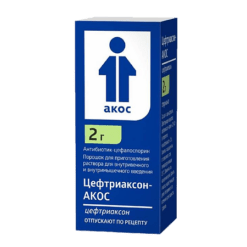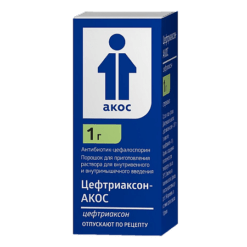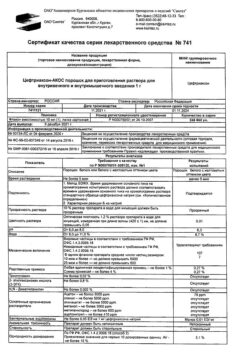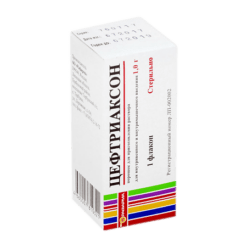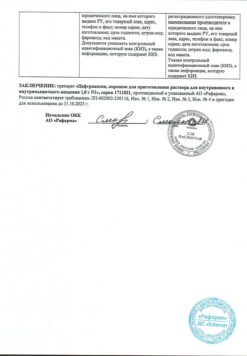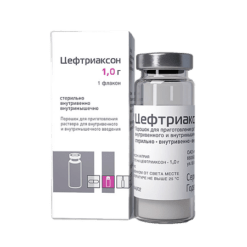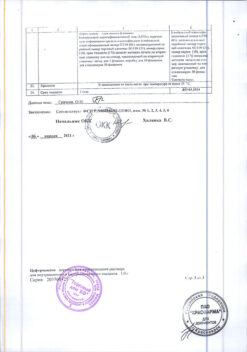No products in the cart.
Ceftriaxone, 1 g 25 pcs
€1.00
Out of stock
(E-mail when Stock is available)
Description
Pharmacotherapeutic group: Antibiotic-cephalosporin
ATC code: J01DD04
Pharmacodynamics:
Ceftriaxone is a hemisynthetic cephalosporin antibiotic of III generation of broad spectrum.
The bactericidal activity of ceftriaxone is due to the inhibition of cell membrane synthesis. The drug is highly resistant to beta-lactamases (penicillinase and cephalosporinase) of Gram-positive and Gram-negative microorganisms. Ceftriaxone is active against the following microorganisms: Gram-negative aerobes: Enterobacter aerogenes Enterobacter cloacae Escherichia coli Haemophilus influenzae (including ampicillin-resistant strains) Haemophilus parainfluenzae Klebssiella spp. (including Klebssiella pneumoniae) Neisseria gonorrhoeae (including penicillinase-producing and non-penicillinase-producing strains) Neisseria meningitidis Proteus mirabilis Proteus vulgaris Morganella morganii Serratia marcescens Citrobacter freundii Citrobacter diversus Providencia spp. Salmonella spp. Shigella spp. Acinetobacter calcoaceticus.
A number of strains of the above microorganisms that show resistance to other antibiotics such as penicillins cephalosporins aminoglycosides are sensitive to ceftriaxone. Certain strains of Pseudomonas aerugenosa are also sensitive to the drug.
The Gram-positive aerobes: Staphylococcus aureus (including strains producing penicillinase) Staphylococcus epidermidis (methicillin-resistant staphylococci show resistance to all cephalosporins including ceftriaxone) Streptococcus pyogenes (group A beta-haemolytic streptococci) Streptococcus agalactiae (group B streptococci) Streptococcus pneumoniae.
Anaerobes: Bacteroides spp. Clostridium spp. (excluding Clostridium difficile).
Pharmacokinetics: When administered intramuscularly, ceftriaxone is well absorbed from the site of administration and reaches high concentrations in the serum. The bioavailability of the drug is 100%. Average concentration in plasma is achieved 2-3 hours after injection. During repeated intramuscular or intravenous administration of ceftriaxone in doses of 05-20 g with an interval of 12-24 hours the accumulation of ceftriaxone in concentrations of 15%-36% exceeds the concentration reached after a single injection. During administration in dose from 015 to 30 g a half-life is from 58 to 87 hours; a volume of distribution – from 578 to 135 l; plasma clearance – 0.58-1.45 l/h renal clearance – 0.32-0.73 l/h. Ceftriaxone is reversibly bound to plasma proteins. About 33% to 67% of the drug is excreted unchanged by the kidneys, the remaining part is excreted with bile in the intestine where it is biotransformed into inactive metabolite.
Penetration into cerebrospinal fluid: in newborns and children with meningitis ceftriaxone penetrates into the cerebrospinal fluid. In case of bacterial meningitis on average 17% of drug concentration in plasma diffuses into the cerebrospinal fluid, approximately four times more than in case of aseptic meningitis. Twenty-four hours after intravenous administration of ceftriaxone at a dose of 50-100 mg/kg of body weight the concentration in the cerebrospinal fluid exceeds 1.4 mg/l.
In adult meningitis patients 2-24 hours after administration of 50 mg/kg of body weight ceftriaxone concentration in the cerebrospinal fluid many times exceeds the minimum suppressive concentration for the most common meningitis pathogens.
Indications
Indications
Active ingredient
Active ingredient
Composition
Composition
How to take, the dosage
How to take, the dosage
The drug is given intramuscularly or intravenously.
The standard dosage regimen
Adults and children over 12 years of age: 1-2 g once daily (every 24 hours). In severe cases or in infections with pathogens of only moderate sensitivity to ceftriaxone the daily dose may be increased to 4 g. Infants (up to 2 weeks): 20-50 mg/kg body weight once a day. The daily dose should not exceed 50 mg/kg of body weight. No distinction should be made between preterm and premature infants when determining the dose.
Infants and young children (from 15 days to 12 years): 20-80 mg/kg body weight once daily.
Children with body weight over 50 kg are prescribed adult doses.
Intravenous doses of 50 mg/kg or more should be administered by drip for at least 30 minutes.
Elderly patients: usual doses for adults without adjustment for age. The duration of treatment depends on the course of the disease. As always with antibiotic therapy, administration of Ceftriaxone should be continued in patients for at least 48-72 hours after normalization of temperature and confirmation of eradication of the pathogen.
Dosage in special cases
In bacterial meningitis in infants and young children, treatment begins with a dose of 100 mg/kg (but no more than 4 g) once daily. After identifying the pathogen and determining its sensitivity, the dose can be reduced accordingly. The best results with meningococcal meningitis were achieved with a treatment duration of 4 days with meningitis caused by Haemophilusinfluenzae – 6 daysStreptococcuspneumoniae – 7 days.
Lyme borreliosis: 50 mg/kg (highest daily dose is 2 g) to adults and children over 12 years old once daily for 14 days.
Gonorrhea (caused by penicillin- and penicillin-negative strains): single intramuscular injection of 250 mg ceftriaxone.
Prophylaxis of postoperative infections depending on the degree of infection risk is administered 1-2 g of ceftriaxone once 30-90 minutes before surgery. Simultaneous (but separate) administration of ceftriaxone and one of the 5-nitroimidazoles, such as ornidazole, has been well established in operations on the colon and rectum.
In patients with impaired renal function there is no need to reduce the dose if liver function remains normal. The daily dose of the drug should not exceed 2 g only in cases of preterm renal failure (creatinine clearance less than 10 ml/min). In patients with impaired liver function there is no need to reduce the dose if renal function remains normal.
In patients with a combination of severe renal and hepatic impairment, plasma ceftriaxone concentrations should be determined regularly and the dose should be adjusted if necessary.
Patients on dialysis do not require additional administration after dialysis. However, the serum ceftriaxone concentration should be monitored for possible dose adjustment since the drug excretion rate may be decreased in these patients.
Interaction
Interaction
Special Instructions
Special Instructions
Contraindications
Contraindications
Side effects
Side effects
Allergic reactions: urticaria chills or fever rash itching rare bronchospasm eosinophilia erythema exudative multiforme (including Stevens-Johnson syndrome) serum sickness anaphylactic shock.
Digestive system disorders: nausea vomiting diarrhea or constipation flatulence abdominal pain taste disorders stomatitis glossitis pseudomembranous enterocolitis liver function disorders (increased activity of “liver” transaminases less often – alkaline phosphatase or bilirubin cholestatic jaundice) pseudocholithiasis gallbladder (“sludge”-syndrome) dysbacteriosis.
Hemopoietic organs: anemia leukopenia leukocytosis neutropenia granulocytopenia lymphopenia thrombocytosis thrombocytopenia hemolytic anemia hypocoagulation decrease of plasma clotting factors concentration (II VII IX X) prolongation of prothrombin time.
Means of urinary system: renal dysfunction (azotemia increase of urea in blood hypercreatininemia glucosuria cylinduria hematuria) oliguria anuria.
Local reactions: phlebitis soreness along the vein soreness and infiltration at the site of injection.
Others: headache dizziness nasal bleeding candida superinfection.
Overdose
Overdose
Pregnancy use
Pregnancy use
Additional information
| Shelf life | 3 years. Do not use after the expiration date printed on the package. |
|---|---|
| Conditions of storage | Store in a dry place protected from light at a temperature not exceeding 25°C. Keep out of reach of children. |
| Manufacturer | Biosintez, Russia |
| Medication form | Powder for preparation of solution |
| Brand | Biosintez |
Other forms…
Related products
Buy Ceftriaxone, 1 g 25 pcs with delivery to USA, UK, Europe and over 120 other countries.


